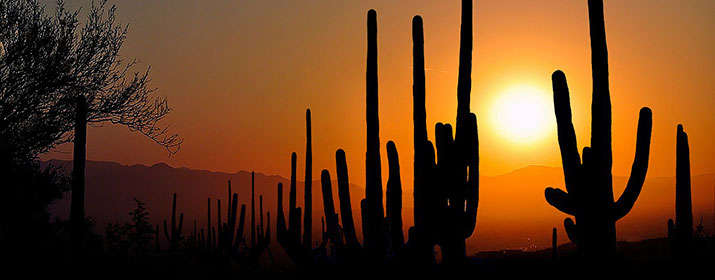
Tucson, Ariz. – Tucson Electric Power (TEP) customers can support service reliability, use cleaner energy resources and possibly even save money this summer by conserving power between 3-7 p.m., the hours of greatest demand on our local energy grid.
“We’re asking customers to help us beat the peak,” said Sam Rugel, TEP’s Director of System Control & Reliability. “Energy resources are going to be tight this summer on the Western grid, so we’ll all be better off if we can reduce usage during hours when our system is under the greatest strain.”
Supporting Reliable Service
Because the electric grid operates in real time, TEP must generate or purchase all the power needed by customers at the moment they use it. Usage fluctuates throughout the day, peaking in late afternoon during the summer as people come home from work, cool their homes, cook meals and enjoy other activities.
Utilities and their customers pay more for energy during those peak usage hours, in part because resources are becoming scarce. In recent years, extreme heat in the western United States has threatened to drive peak electric use beyond the level our regional grid can serve.
While TEP has secured enough resources to cover customers’ anticipated usage, supplies could be compromised by regional power plant outages, wildfires or an extended Western heat wave. Using less energy between 3-7 p.m. helps ease the pressure on the grid, reducing the need for expensive on-peak power purchases and reducing the threat of energy shortages that could cause outages.
If energy supplies can’t keep up with demand, grid operators must find ways to reduce usage to balance the loads and resources They start by asking large industrial users to suspend operations and shutting off service to customers that have agreed to occasional interruptions through “demand response” programs or interruptible rates. Next come appeals to the public for conservation, though there isn’t always time for this step. As a last resort, grid operators may start “rolling blackouts” – short outages that are rotated from one area of town to another to limit the impact for any one group of customers.
“Fortunately, our customers have rarely experienced these kinds of interruptions. But energy supplies are tighter than ever, particularly in California,” Rugel said. “Serving customers on-peak is likely to be more expensive, and we might have a harder time finding replacement power if our own generating resources suffer an outage or wildfires force transmission line shutdowns.”
Using Cleaner Energy
Using energy off-peak can allow customers to capitalize on cleaner energy. Arizona enjoys abundant solar energy during the middle of the day, but that production begins to fade during the late afternoon. Utilities must ramp up natural gas generation to satisfy customers’ energy needs between 3-7 p.m.
“If you keep an eye on our Clean Energy Tracker, you’ll see that our solar energy systems produce the most power around noon, when the sun is directly overhead. You’ll also see that our wind farms are most productive during the early morning and later in the evening, after the sun sets,” explained Ted Burhans, Director of Emerging Technology and Innovation.
Customers who shift the majority of their energy usage to mornings and early afternoons from peak times will use a larger share of solar energy to power their dishwashers, washing machines and other appliances and electronics.
Similarly, evening energy use taps into our expanding wind energy resources. Typically, winds start to kick up at sunset in southeastern New Mexico, allowing us to generate clean wind power at our new Oso Grande Wind farm. This 250-megawatt site will generate enough power each year to serve the annual electric needs of nearly 100,000 homes.
Saving Money
Reducing on-peak usage will help keep energy affordable, as TEP’s wholesale power costs are passed along through the Purchased Power and Fuel Adjustment Charge (PPFAC) on customers’ bills.
But customers using any of TEP’s three time-of-use (TOU) pricing plans can also save money on their own bills right away by reducing their on-peak energy usage.
TEP’s TOU plans offer lower rates during “on-peak” hours, which change with the seasons. Summer on-peak hours are 3-7 p.m. weekdays May through September, while winter on-peak hours are 6-9 a.m. and 6-9 p.m. October through April. All weekends and major holidays are always off-peak.
With new energy use habits, it’s easy to save money and energy on these plans. Suggested strategies include:
- Cleaning clothes at midday and waiting to run your dishwasher until you turn in for the night.
- Using ceiling fans to cool yourself in the late afternoons rather than running the air conditioner to cool an entire room.
- Programming your pool pump to operate at midday instead of in the late afternoon.
- Pre-cooling your home before 3 p.m., when summer on-peak hours begins. To do this, set the thermostat three degrees lower than your preferred setting at noon, then move to a higher temperature setting during on peak hours.
- Cooking meals in your oven or on your stove before 3 p.m. and then heating them up in the microwave at dinnertime.
“With all of us doing our part to conserve energy during late afternoons this summer, we can ease the stress on our regional grid, make good use of our renewable energy and enjoy lower energy costs,” Rugel said.
TEP provides safe, reliable electric service to more than 433,000 customers in Southern Arizona. For more information, visit tep.com. TEP and its parent company, UNS Energy, are subsidiaries of Fortis Inc. (NYSE: FTS), which owns utilities that serve more than 3 million customers across Canada and in the United States and the Caribbean. For more information, visit fortisinc.com.
News Media Contact:
Joseph Barrios
(520) 884-3725
jbarrios@tep.com






